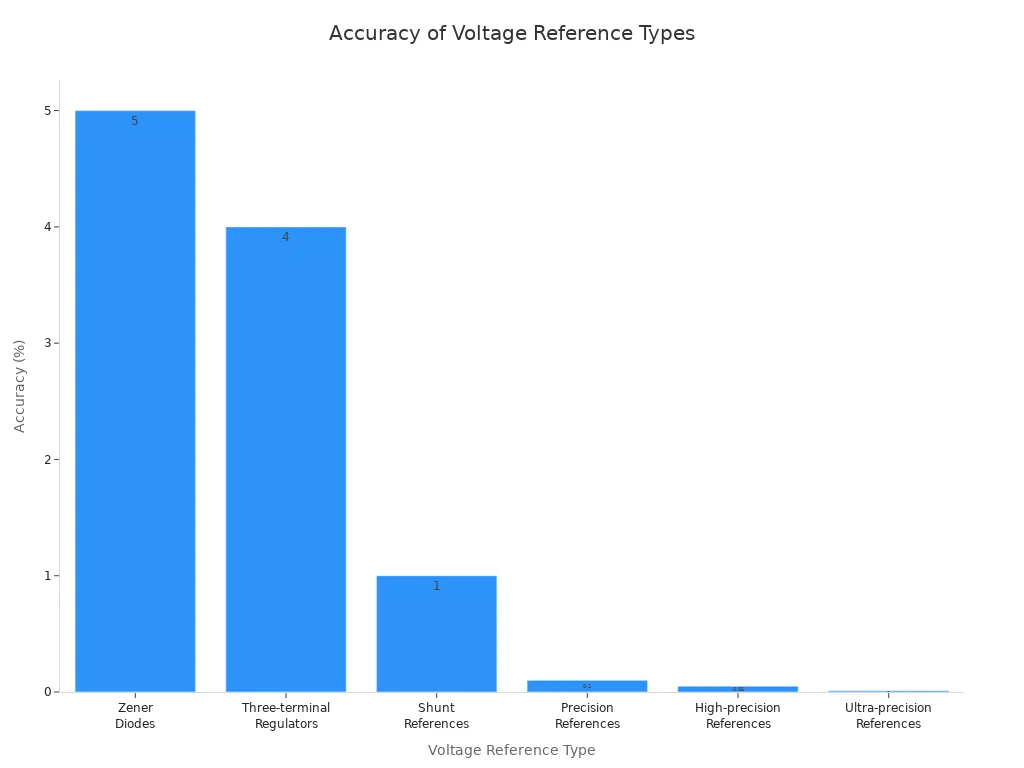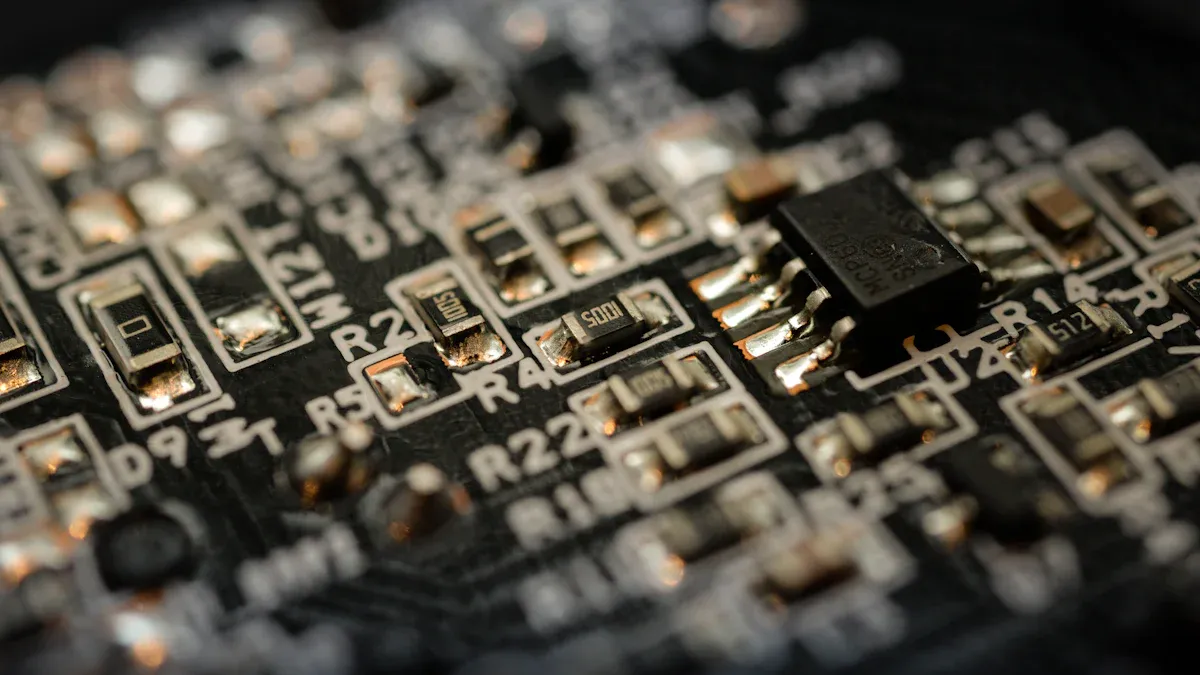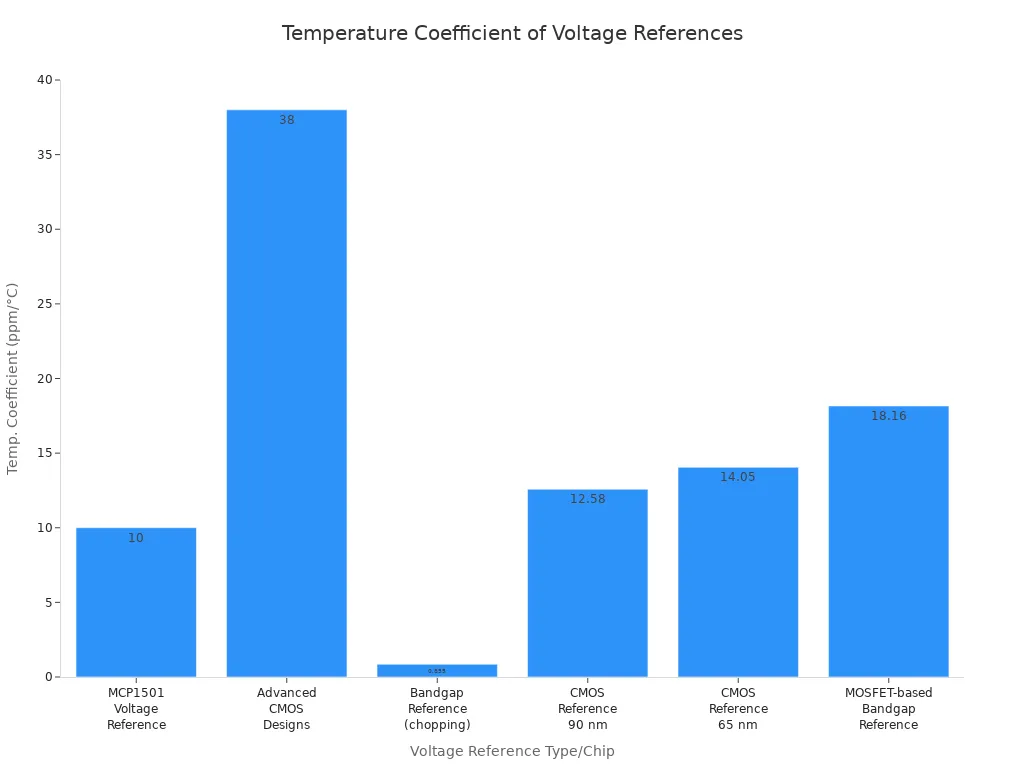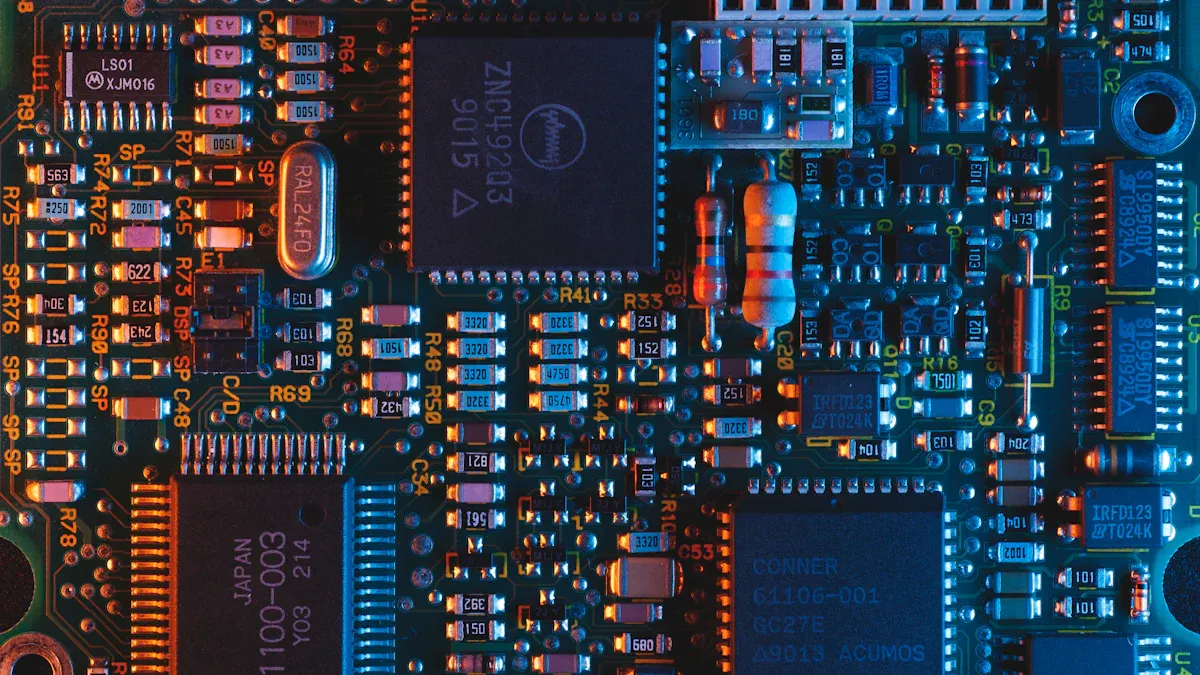You want your electronic chips to work well on any circuit pcb board. To do this, you need to match voltage reference features to what your project needs.
-
Studies show that temperature drift, noise, and long-term stability can change how accurate and reliable your chip is.
-
Engineers often have problems with component tolerance, current accuracy, and noise filtering when they use pcb design tools.
-
Picking the right voltage reference helps your circuits give correct results, even when things around them change.
Key Takeaways
-
Write down your project’s voltage, accuracy, temperature, and power needs before you pick a voltage reference chip.
-
Look at important specs like output voltage, starting accuracy, temperature changes, noise, and package type to find the best one.
-
Use datasheets and online tools to compare voltage references and learn about their pros and cons.
-
Build and test your circuit with the voltage reference you picked to find problems early and make sure it works well.
-
Choose a stable, low-drift voltage reference to keep your chips accurate and your device working well for a long time.
Application Needs for Electronic Chips
Before picking a voltage reference, you should know what your electronic chips need. Make a list of everything your project must have. Doing this helps you not make mistakes and makes later steps easier.
Voltage & Accuracy
-
Write down the voltage levels your chips need. Microcontrollers often use built-in references like 1.1 V, 2.0 V, 2.5 V, or 2.56 V. External references, like 2.5 V or 5 V, can give you better results.
-
Check how accurate your voltage reference must be. For a 12-bit ADC, you need accuracy better than 0.024% to get all the details. Precision references, like the LT1009, give 2.5 V with ±0.2% tolerance. This helps your measurements stay steady.
-
Use this table to see how different voltage references compare:
Voltage Reference Type
Typical Voltage Values (V)
Accuracy Range
Notes
Zener Diodes
~5.1
~5% (inexpensive)
Simple, low cost, accuracy varies
Three-terminal Regulators
5.0
~4% (standard 7805)
More stable than zener, short-circuit proof
Shunt References (e.g. LM4040)
5.0
1%
Less sensitive to current variations
Precision References (e.g. LM4040AIZ-5.0)
5.0
0.1%
Moderate temperature coefficient (~100 ppm/°C)
High-precision References (e.g. AD586L)
5.0
0.05%
Low temperature coefficient (5 ppm/°C), low aging rate
Ultra-precision References (e.g. Intersil X60008C)
1.024 to 5.0
0.01%
Very low temperature coefficient (5 ppm/°C), low current consumption
-
You can see that accuracy gets better with higher precision references.

Temperature & Current
-
Think about the temperature range where your chips will work. If your device faces big temperature changes, pick a voltage reference with a low temperature coefficient. This keeps your readings right even if it gets hot or cold.
-
High temperatures can cause problems. Your device might not last as long, work as well, or could even be unsafe. For example, in cars, bad temperature stability can make sensors wrong and systems fail.
-
Check how much current your circuit will use from the voltage reference. Some references are better for low current, while others can handle more.
Special Constraints
-
Write down any special needs for your project. Portable devices need small and light voltage references to save space and battery.
-
Power use is important. Using less power means your battery lasts longer and your device stays cooler. Efficient voltage references help your chips run better and last longer.
-
If your project will be in tough places, like factories, you need strong voltage references. They should handle temperature swings and electrical noise.
-
Use power-saving features, like standby modes, to save energy when your device is not working.
Tip: Write down all your needs before you go to the next step. This helps you choose the best voltage reference for your chips.
Key Voltage Reference Parameters

When you pick a voltage reference, you must check some important things. These things decide how well your electronic chips will work. Here are the main things to look at:
Output Voltage
Start by making sure the output voltage matches your circuit. Most voltage reference chips give fixed outputs like 2.5 V or 5.0 V. Some old types, like zener diodes, can go from 1.2 V to 13 V. But most new chips use 2.5 V to 5 V. Pick a voltage that works for your microcontroller, ADC, or other parts.
Initial Accuracy
Initial accuracy shows how close the output voltage is to what the datasheet says right after you put in the chip. Makers test this at room temperature with no load. You will see this as a percent or in ppm. For example, a 5 V reference that gives 5.0005 V has a 100 ppm error. High-precision chips can reach 0.02% accuracy. If you cannot fix your circuit later, pick a chip with high initial accuracy.
-
Initial accuracy is the worst output voltage after making the chip.
-
It is tested at 25°C with set rules.
-
Shown as a percent or ppm.
-
Laser trimming can make this better.
Temperature Coefficient
The temperature coefficient (TC) tells how much the output voltage changes when it gets hotter or colder. A lower TC means the voltage stays more steady. For example, the MCP1501 chip has a TC of 10 ppm/°C. Some new chips can go as low as 0.855 ppm/°C. A lower TC helps your circuit stay correct in hot or cold places.

Noise & Stability
Noise and stability are very important for circuits that measure small signals. Too much noise can make your ADC readings jump or freeze. Good voltage references keep noise under 10 µV rms. Stability means the voltage does not change over time. Long-term stability is important for factories, so you do not have to fix things often.
Tip: Always check the long-term stability rating, which is usually in ppm per 1000 hours. Less drift means your electronic chips will stay correct longer.
Package & Architecture
The package type changes how the chip fits on your PCB and how it handles heat. QFN and BGA packages are good for tight spaces because they spread heat well. CSP packages are very small but may not cool as well. The inside design, like flip chip or wire bond, also changes how the chip handles fast signals and heat.
You also need to choose between shunt and series types:
-
Series references have three pins and work well with changing loads. They give better accuracy and stability.
-
Shunt references have two pins and need an outside resistor. They are good for steady loads and high-voltage circuits.
Compare Options
When you start comparing, you need real data and tools. This helps you pick the best voltage reference for your project. Here are three easy steps to compare voltage reference choices for your electronic chips.
Datasheets
First, read datasheets from companies you trust. These papers tell you the specs for each voltage reference chip. Look for things like initial accuracy, temperature coefficient, supply current, and long-term stability. Sometimes, technical articles from the company give more details than datasheets. For example, Analog Devices checks the LTC6652 at different temperatures, not just room temperature. This lets you see if a chip stays accurate in hot or cold places. Some datasheets only say a chip works at high temperatures, but not if it stays precise. Always look for notes about thermal hysteresis and long-term drift, because these can change your results over time.
Tip: Be careful when reading datasheets. Temperature drift, changes in supply voltage, and part tolerances can all affect how a voltage reference works in your circuit.
Selection Tools
Online selection tools help you filter and compare voltage reference chips. You can sort by type, package, life cycle, and electrical features. Here is a quick guide to common filters:
|
Attribute Category |
Examples of Filters / Options |
|---|---|
|
Voltage Reference Type |
Fixed, Programmable / Adjustable, Other |
|
IC Package Type |
DIP, SC-70, SOIC, SOT23, TO-3, TO-39 |
|
Life Cycle Stage |
Not Recommended, Last Shipments, Removed |
|
Operating Mode |
Bandgap, Buried-Zener, Shunt / Zener |
|
Electrical Parameters |
Initial Accuracy, Temperature Coefficient, Supply Current, Input Voltage |
Selection tools help you quickly find chips that fit your needs for electronic chips. This saves time and helps you avoid mistakes.
Trade-Offs
You have to balance a few things when picking a voltage reference:
-
Zener (shunt) types use more power and are less precise.
-
Bandgap (series) types use less power and are more accurate, but may not work with as many input voltages.
-
Low-power designs need chips with very low quiescent current, sometimes under 1 µA, to save battery life.
-
High-precision designs need chips with low noise, low temperature drift, and high initial accuracy, even if they use more power.
-
You also need to check if the chip can handle the load current your circuit needs.
Note: Real projects, like medical patches or field transmitters, show how picking the right trade-off can make both accuracy and battery life better.
Validate & Test

Prototyping
First, build a test circuit with your voltage reference. Put the chip near the analog part of your board. This helps stop noise and voltage loss. Use decoupling capacitors as the datasheet says. These keep the voltage steady and block unwanted signals. Make analog traces short and far from digital lines. This stops interference.
When making your PCB, use zero-ohm resistors as jumpers. They let you change the circuit easily. You can separate parts for testing and add test points. Zero-ohm resistors also help you change resistor values later. They make fixing and updating the board much easier.
Tip: Add things like heat sinks or copper planes for cooling. This keeps the temperature steady and helps your voltage reference work well.
Real-World Testing
Test your circuit in real situations. Do system tests to see how the voltage reference works in your project. Check how the chip does with different loads and temperatures.
-
Try shock tests to see if the chip can handle bumps.
-
Use moisture tests to check if it works in wet places.
-
Do thermal shock tests to see how it handles fast temperature changes.
-
Test for vibration to make sure it works in moving devices.
-
Check if it can handle heat and chemicals from soldering.
Also, measure things like DC and AC performance. Test for power supply noise and signal quality. These tests help you find problems before you finish your design.
Reliability Check
Do reliability tests to make sure your voltage reference lasts a long time. Use stress tests with extra voltage and heat to speed up aging. On-chip monitors watch for changes in how the chip works. Look for any changes in voltage or timing. After stress, let the chip rest and see if it goes back to normal.
This helps you find weak spots early. You can fix problems before selling your product. Good voltage references keep your circuits working right and safe.
Note: Doing these steps makes sure your voltage reference works well in hard places and for a long time.
You can pick the best voltage reference by using these four steps. Following a plan helps you make fewer mistakes and get better results.
-
A steady voltage reference helps you measure things more accurately.
-
Low temperature drift and good long-term stability help stop mistakes.
-
Picking the right type and design makes your system work better.
|
Error Source |
Impact on Accuracy |
Mitigation Techniques |
|---|---|---|
|
Op-amp offset |
Very large, nonlinear temp. dependence |
Layout optimization, chopper stabilization |
|
Package shift |
Large, post-packaging effect |
Careful packaging, post-package trimming |
|
Resistor mismatch |
Large, linear temp. dependence |
Material choice, trimming |
If your project has special needs, look at datasheets or talk to experts. Good voltage references help your devices work well and stay correct for a long time.
FAQ
What is a voltage reference chip?
A voltage reference chip gives one steady voltage. It helps your circuits measure things the right way. The voltage does not change much if the temperature or power changes.
How do you know which voltage reference to pick?
You need to think about what your project needs. Check the voltage, accuracy, and temperature range. Use datasheets and selection tools to help you. Make a list of your needs before you decide.
Why does temperature coefficient matter?
The temperature coefficient tells how much the voltage changes when it gets hotter or colder. If the number is lower, the voltage stays more steady. This helps your circuit work well in all kinds of weather.
Can you use a zener diode as a voltage reference?
You can use a zener diode for easy projects. It works best if you do not need high accuracy. For better results, use a precision voltage reference chip.






